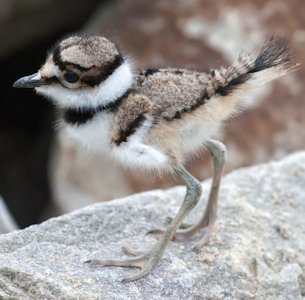
|
Bird's Patterns of Chick Development -- Page 1
To a great extent, the kind of care require is determined by the development pattern of the Chicks. Ornithologists separate those development patterns into two kinds: altricial and precocial. The chicks of altricial species--which includes songbirds, woodpeckers, hummingbirds, hawks, and owls--are naked and blind when they hatch, and are too weak to do anything but open their mouths to be fed by the parents. Altricial chicks usually remain in the nest for two or more weeks, until they have developed enough plumage, strength, and coordination to fly short distances. After fledging they may remain dependent upon the parents several weeks longer for protection and feeding. You may see full sized young birds at this time begging and harassing their parents for food. In contrast, the chicks of precocial species, such as ducks, geese, grouse, pheasants, shorebirds, and grebes, are appealing and capable birds at birth. At hatching they are covered with a thick layer of down, have well-developed legs and bills, and their eyes are open. Sandpiper and plover chicks may leave the nest within hours of hatching, and before they are one day old can run, hide, peck at insects on low vegetation. The parent or parents do not need to carry food to these chicks, which is the most-consuming job of parents of altricial chicks. This Young Killdeer is typical of most precocial birds. Thickly covered with camouflaging down and capable of moving about shortly after hatching, such birds are almost independent of their parents. |
| Killdeer is a Typical Precocial Bird | |
| ⇦ Back to Chick Development - Page 5 Return to Bird Nesting Choices On to Chick Development - Page 2 ⇨ | |